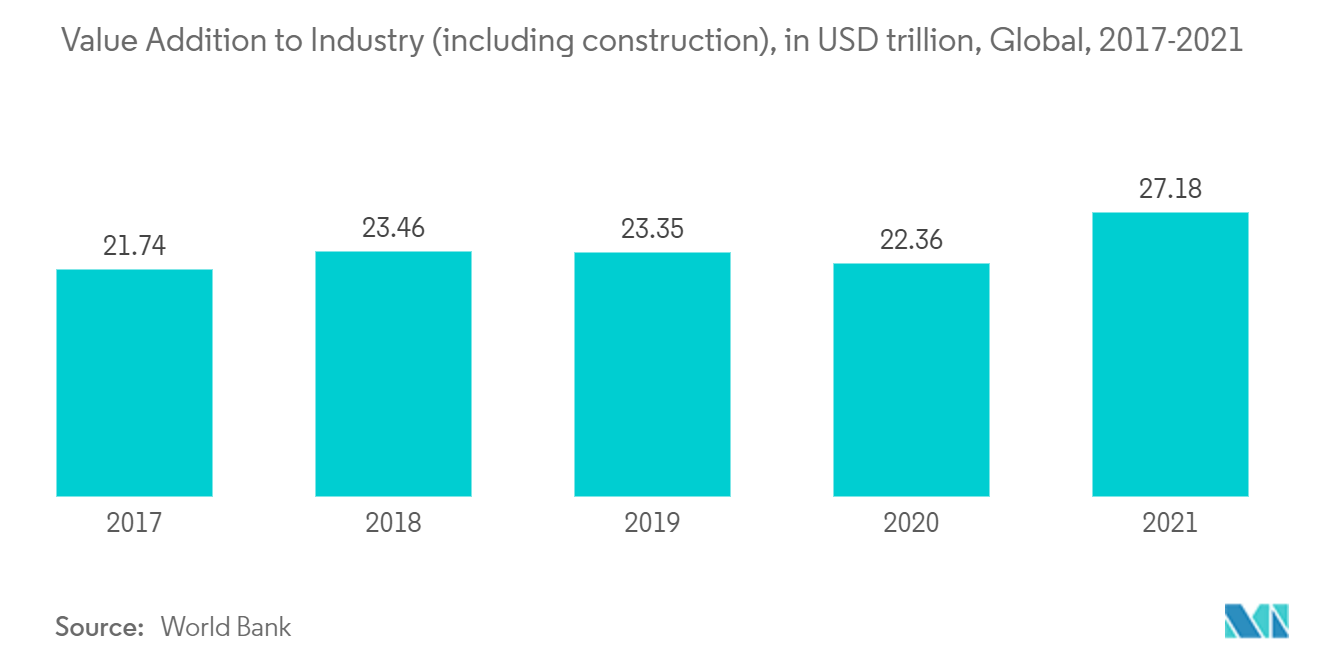Market Trends of Formaldehyde Industry
This section covers the major market trends shaping the Formaldehyde Market according to our research experts:
Construction Industry to Dominate the Market
- The construction industry is the dominant segment owing to large-scale formaldehyde consumption in construction, remodeling activities, and furniture production.
- Formaldehyde-based resins are used to create composite and engineered wood products for moldings, furniture, countertops, cabinetry, shelving, stairs, wall sheathing, support beams, flooring, and trusses, among many other household furnishings and structures.
- As per the Ministry of Housing and Urban-Rural Development forecast, China's construction sector is expected to maintain a 6% share of the country's GDP going into 2025. Keeping in view the given forecasts, the Chinese government unveiled a five-year plan in January 2022 focused on making the construction sector more sustainable and quality-driven.
- In May 2022, the development of the Crux natural gas field, off the coast of Western Australia was given final investment approval by Shell Australia Pty Ltd (Shell Australia) and its joint venture partner, SGH Energy. The current Prelude floating liquefied natural gas (FLNG) facility will receive additional natural gas supplies from Crux. The project's construction started in 2022 and the first gas is expected in 2027.
- The United States boasts a colossal construction sector that plays a prominent role in commercial, industrial, institutional, residential, infrastructure, energy, and utility construction. The construction spending during January 2022 was estimated at a seasonally adjusted annual rate of USD 1,677.2 billion. Further, construction spending in the United States rose 1.3% in February, as compared to a seasonally adjusted annual rate of USD 1.677 trillion in January of 2022.
- Germany has the largest construction industry in Europe. The construction industry in the country has been growing at a slow pace, majorly driven by increasing new residential construction activities. The non-residential and commercial buildings in the country are expected to witness significant growth prospects during the forecast period. The growth is likely to be supported by lower interest rates, an increase in real disposable incomes, and numerous investments by the European Union and the German government.

Asia-Pacific Region to Dominate the Market
- The Asia-Pacific region stands to be the dominant market for the automotive and construction industry. Factors such as good adhesive strength and moisture resistance properties of formaldehyde-based resins and continuous demand from the furniture sector are likely to drive market growth.
- According to the International Energy Agency (IEA) and BP Statistical Review of World Energy 2022, China is one of the largest importers of crude oil, importing more than 10 million barrels a day in 2020. According to the National Bureau of Statistics, the average crude oil throughput at Chinese refineries was 14.5 million in 2021, witnessing a 7.3% y-o-y hike. Additionally, according to the China National Petroleum Corporation (CNPC), the average annual increase of natural gas demand in the country is expected to exceed 20 billion cubic meters during the 14th Five-Year Plan (2021-2025) and reach 430 billion cubic meters in 2025.
- India is gearing up to embrace urbanization by leveling up its existing infrastructure in cities. To support the same, the country has overhauled its reforms such as the Real Estate Act, GST, REITs, etc., to eliminate unnecessary lags in the construction targets. Industrial and commercial infrastructure in the country has emerged as one of the high-growth sectors. The Indian government has been formulating initiatives like easing the rules to attract FDI inflow in the construction sector to expedite development across the nation.
- The oil and gas industry is one of India's eight core industries. India is the third largest consumer of oil and energy, and it is the fourth largest importer of liquified natural gas in the world. According to the India Brand Equity Foundation, the country's oil demand is projected to double the current demand figures reaching 11 million barrels per day by 2045. On the other hand, the consumption of natural gas is projected to grow by 25 billion cubic meters following an annual average growth rate of 9% till 2024.
- In Japan, the 65-and-above demographic represents around 30% of the country's total population and is expected to reach around 40% by 2050. The rapidly aging Japanese population, the increasing number of patients with chronic and lifestyle diseases, and universal health insurance coverage and regulatory measures are driving the Japanese healthcare market. Japan is boosting its medical sector as its citizens are getting older at a faster rate than the citizens of any other nation.
- Furthermore, Indonesia plans to develop a USD 1 billion worth 900 MW hydropower project in the Kayan River in the North Kalimantan (Kalutara) province. The project stands at the EPC stage, with a startup date planned for 2022. The project is expected to be commissioned after the completion of construction in 2025.
- As per the International Trade Administration, in 2021, the local production of medical devices in South Korea was valued at USD 11,257 million. The exports of medical devices stood at USD 8,629 million, while the imports from the United States stood at USD 5,353 million.
- Also, the Asia-Pacific region is the largest automotive manufacturing hub, registering almost 60% production share of the world. According to OICA, in the first nine months of 2021, the total production of vehicles stood at 32.67 million units, an increase of 11% compared to the same period last year.


